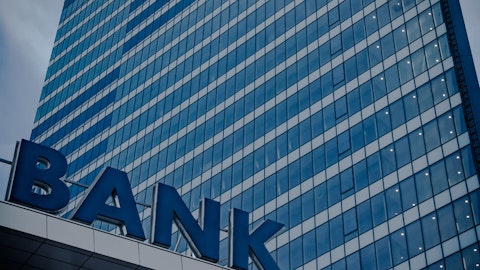Brendan Coughlin : Yes, sounds good. So much of our low-cost deposit book is in the consumer space and obviously was buoyed through the pandemic by all the stimulus. We saw the rundown of the stimulus rate peak in May, and it started to abate as we got into the summer and the fall, although it’s still kind of spending down at a decent clip. We do have a lot of analytics, benchmarking analytics on how we’re doing, and this is supportive of John’s commentary that the franchise is performing in a very different level than it did the last upgrade cycle. We believe we’re #2 in the peer set in terms of DDA consumer migration. So we’re performing exceptionally well on the DDA side. And when you look at beta on the consumer side, as compared with the growth that we’re getting, it appears for about 400 basis points to 500 basis points better in net growth on the consumer book through the cycle so far and our betas are mildly better.
So more growth slightly better cost on the core book. That’s excluding Citizens Access. That’s a real indicator of the quality of franchise and the quality of the customer base that we’ve moved from sort of a community banking, high-priced deposit focus to deeply engaged primary banking relationships. So we expect the pay down of low-cost deposits to continue to slow obviously, dependent on rate environment and the economy that potentially could change. What I do feel really confident in is that our relative performance to peers will be strong and we’ll continue to outperform on the consumer side and the stability of our low-cost book. At the individual customer level, they still have a little bit more liquidity in their balances than they did pre-pandemic, that’s largely held by affluent and high net worth individuals, our mass market book and even in the mass affluent space, they’ve sort of moderated back down to operating floors.
So I think those are all signs that would support the continued slowdown in the rundown of low-cost deposits pending any recessionary impact that may bring them below operating floors. So we feel pretty good. And just on the uninsured and insured deposit front, we saw a little bit of a blip on the uninsured in March. And since March, that has been incredibly stable and all parts of the book have been growing. So all the fundamentals point to continued trajectory of stability and certainly continue to outperform. And then in addition to that, we’re controlling what we can control is we’re performing in the top quartile in the United States in terms of household acquisition growth. The New York market, as John pointed out, is helping to give us an extra lever to drive low-cost deposit growth over and above just the portfolio trends, which are generally out performing.
So we do believe we’ve got a distinctive amount of levers for the franchise to continue to outperform in the medium-term outlook on low-cost deposits.
Peter Winter : Very helpful. And then just one quick housekeeping. I just want to confirm, John, you said that the private — the expense outlook for next year being flat. That includes the Private Bank build-out expenses?
John Woods : Yes. The underlying expenses to be flat next year, including the Private Bank as well as Non-Core.
Operator: Your next question comes from the line of Ken Usdin from Jefferies.
Kenneth Usdin : Just a follow-up on that last question. John, I just wanted to ask you, I know that the Private Bank buildout was $35 million of cost this quarter. Just wondering if there’s any changes to your expectation of what that would trend like going forward as part of that cost commentary?
John Woods: I think Brendan will probably have some color on this. So it’s pretty similar into the fourth quarter. And then, of course, into next year, you see it starting to migrate towards a — instead of being an EPS drag, it gets back to breakeven when you get out into 2024. And then more broadly, a 5% contribution to EPS is our outlook there. But…
Brendan Coughlin : Yes. There’ll be into Q4, some very modest upticks in the low 40s potentially. And the reasons for that, we hired the majority of the team as you all know, in the early part of the summer, the influences on that nudging up our successful securing of various different Private Banking offices coast-to-coast to house the team and start to bring in customers into the platform, some operating expenses clients come on board as well as we’re playing some very selective second-tier office. There’s still a lot of talent in motion and this quarter after the first 150. We also hired another 25 really top A-list talent folks in all of those same offices that we opened in the summer. And so we’re going to be selective. But as we see the right talent pop up, we’re going to grab them — add them to the team. So…
Bruce Van Saun: The other thing, just in the way the comp is structured, Ken, that the folks who came over on guarantees as if they’re fully producing. So as the revenues come in, there won’t be incremental costs. They’ll just be kind of earning those pay levels. So another factor to consider.
Kenneth Usdin : Yes, that’s a great point. And then as a follow-up, you guys have done a great job over the years on the TOP program and just I take your commentary about holding costs flat, inclusive of these extra builds that would imply a real turn exiting the year given that you ramped through the year on cost this year. And John, I know you mentioned AI as a piece of that increment. But you’ve done 100 plus of TOP each year. I’m just wondering like where else would you be digging in across the organization to get that magnitude of what seems to be a pretty meaningful implied to extra cost save out of the numbers next year.





